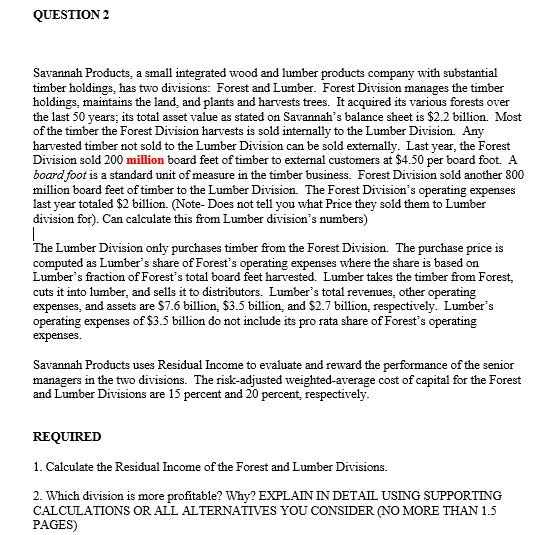
QUESTION 2 Savannah Products, a small integrated wood and lumber products company with substantial timber holdings, has two divisions: Forest and Lumber. Forest Division manages the timber holdings, maintains the land, and plants and harvests trees. It acquired its various forests over the last 50 years; its total asset value as stated on Savannah's balance sheet is $2.2 billion. Most of the timber the Forest Division harvests is sold internally to the Lumber Division. Any harvested timber not sold to the Lumber Division can be sold extermally. Last year, the Forest Division sold 200 million board feet of timber to extenal customers at $4.50 per board foot. A board foot is a standard unit of measure in the timber business. Forest Division sold another 800 million board feet of timber to the Lumber Division. The Forest Division's operating expenses last year totaled $2 billion. (Note- Does not tell you what Price they sold them to Lumber division for). Can calculate this from Lumber division's numbers) The Lumber Division only purchases timber from the Forest Division. The purchase price is computed as Lumber's share of Forest's operating expenses where the share is based on Lumber's fraction of Forest's total board feet harvested. Lumber takes the timber from Forest cuts it into lumber, and sells it to distributors. Lumber's total revenues, other operating expenses, and assets are $7.6 billion, $3.5 billion, and $2.7 billion, respectively. Lumber's operating expenses of $3.5 billion do not include its pro rata share of Forest's operating expenses Savannah Products uses Residual Income to evaluate and reward the performance of the senior managers in the two divisions. The risk-adjusted weighted-average cost of capital for the Forest and Lumber Divisions are 15 percent and 20 percent, respectively REQUIRED 1. Calculate the Residual Income of the Forest and Lumber Divisions 2. Which division is more profitable? Why? EXPLAIN IN DETAIL USING SUPPORTING CALCULATIONS OR ALL ALTERNATIVES YOU CONSIDER (NO MORE THAN 1.5 PAGES) QUESTION 2 Savannah Products, a small integrated wood and lumber products company with substantial timber holdings, has two divisions: Forest and Lumber. Forest Division manages the timber holdings, maintains the land, and plants and harvests trees. It acquired its various forests over the last 50 years; its total asset value as stated on Savannah's balance sheet is $2.2 billion. Most of the timber the Forest Division harvests is sold internally to the Lumber Division. Any harvested timber not sold to the Lumber Division can be sold extermally. Last year, the Forest Division sold 200 million board feet of timber to extenal customers at $4.50 per board foot. A board foot is a standard unit of measure in the timber business. Forest Division sold another 800 million board feet of timber to the Lumber Division. The Forest Division's operating expenses last year totaled $2 billion. (Note- Does not tell you what Price they sold them to Lumber division for). Can calculate this from Lumber division's numbers) The Lumber Division only purchases timber from the Forest Division. The purchase price is computed as Lumber's share of Forest's operating expenses where the share is based on Lumber's fraction of Forest's total board feet harvested. Lumber takes the timber from Forest cuts it into lumber, and sells it to distributors. Lumber's total revenues, other operating expenses, and assets are $7.6 billion, $3.5 billion, and $2.7 billion, respectively. Lumber's operating expenses of $3.5 billion do not include its pro rata share of Forest's operating expenses Savannah Products uses Residual Income to evaluate and reward the performance of the senior managers in the two divisions. The risk-adjusted weighted-average cost of capital for the Forest and Lumber Divisions are 15 percent and 20 percent, respectively REQUIRED 1. Calculate the Residual Income of the Forest and Lumber Divisions 2. Which division is more profitable? Why? EXPLAIN IN DETAIL USING SUPPORTING CALCULATIONS OR ALL ALTERNATIVES YOU CONSIDER (NO MORE THAN 1.5 PAGES)







